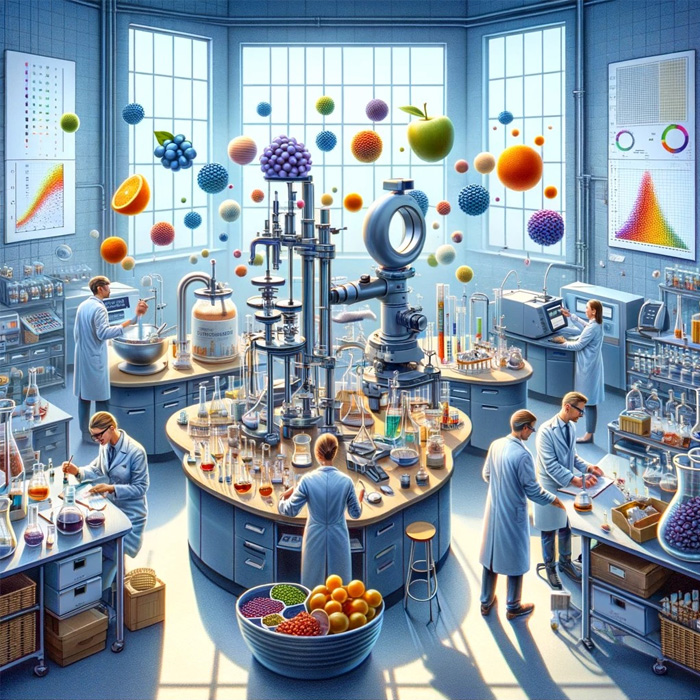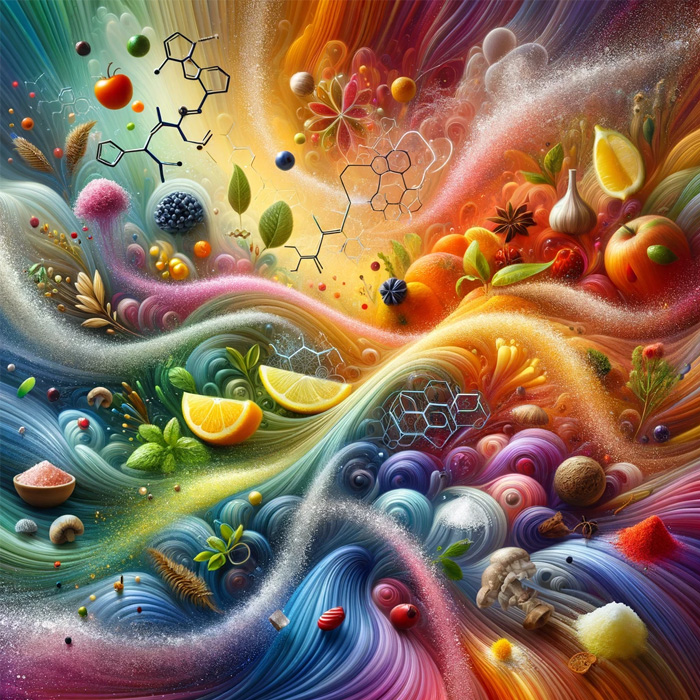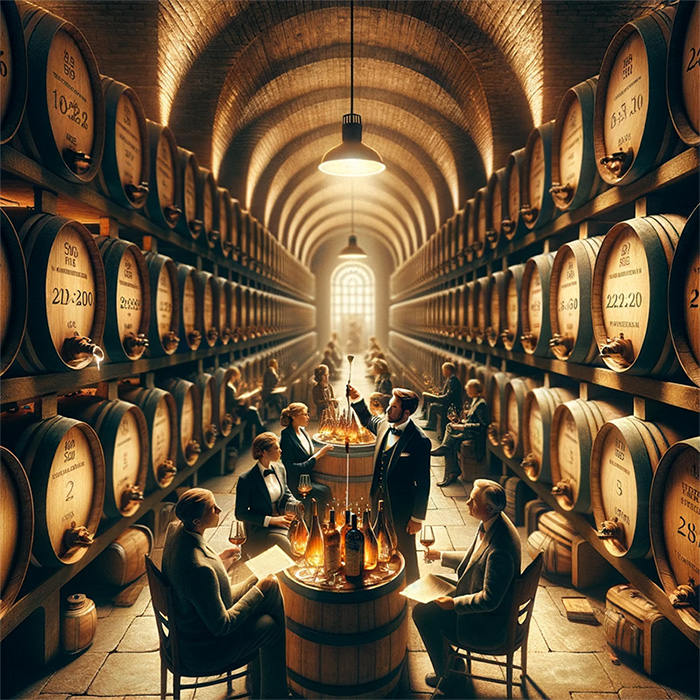The Quest to Match Flavors
 Embarking on the quest to match complex flavors is akin to navigating a labyrinth of taste and aroma, where each turn unveils new challenges and wonders. This journey, set at the intersection of art and science, requires a deep dive into the myriad of ingredients that make up flavor formulations—from the purity of aroma chemicals to the natural variability of essential oils and the critical role of solvents. Each ingredient contributes to a mosaic of taste, creating a complex puzzle that flavorists strive to replicate. The endeavor to match a flavor is not merely a task; it is an odyssey that demands an intricate understanding of chemistry, sensory perception, and the subtle interplay between components.
Embarking on the quest to match complex flavors is akin to navigating a labyrinth of taste and aroma, where each turn unveils new challenges and wonders. This journey, set at the intersection of art and science, requires a deep dive into the myriad of ingredients that make up flavor formulations—from the purity of aroma chemicals to the natural variability of essential oils and the critical role of solvents. Each ingredient contributes to a mosaic of taste, creating a complex puzzle that flavorists strive to replicate. The endeavor to match a flavor is not merely a task; it is an odyssey that demands an intricate understanding of chemistry, sensory perception, and the subtle interplay between components.
As we explore the statistical odds of replicating flavors, we venture into a world where precision meets creativity. From the hopeful search for a four-leaf clover in matching a flavor with just a few ingredients to the daunting odds of completing a jigsaw puzzle blindfolded for those with 30+ components, the process highlights the vast spectrum of difficulty and the remarkable skill required at each level. This introduction to flavor matching reveals the challenges and triumphs in the art and science of flavor replication, underscoring the dedication, expertise, and innovative spirit that drive the food and beverage industry forward.
Please note that we have taken the liberty in making some simplifications since this is a very complex subject. Some of these include not involving costing of ingredients/formulations & regulatory standards for ingredients. It is intended to generally explain the complexities of matching flavors.
Flavors are Complex & Difficult to Match
 Ingredient Complexity
Ingredient Complexity
Flavor formulations can vary significantly, encompassing a range from simple mixtures to intricate combinations of over 100 ingredients. These ingredients include pure aroma chemicals, natural products like essential oils and extractives, and various solvents, each contributing to the flavor’s complexity:
Aroma Chemical Variability: Purity levels, geographical origins, and specific impurities in aroma chemicals introduce significant variability. This diversity, even among chemicals sourced from different suppliers or countries, complicates the replication process.
Natural Product Complexity: The inclusion of natural products adds another layer of complexity due to their variability related to geographical origin, extraction processes, and manufacturing nuances. This variability impacts the consistency and replicability of flavors.
Solvent Impact: Solvents and their proportions are critical, influencing the solubility and sensory perception of flavor compounds. Minor variations in solvent use can markedly affect the flavor profile.
Dynamic Flavor Profiles
Flavors are inherently dynamic, influenced by chemical reactions, degradation, and intentional formulation strategies:
Chemical Interactions and Degradation: Ingredients within a flavor can interact with each other and with impurities, altering the flavor over time. Degradation influenced by storage conditions (temperature, light, oxidation) further complicates flavor stability.
Strategic Formulation Complexity: Some flavors are deliberately complex to replicate, incorporating reactions like the Maillard reaction, producing a broad spectrum of chemicals and making exact replication challenging.
Analytical and Sensory Evaluation Challenges
The endeavor to match flavors faces hurdles in both analytical and sensory dimensions, compounded by the addition of natural products:
GC-MS Analysis: While GC-MS detects compounds at low concentrations, replicating a flavor accurately demands not just detection but precise quantification and understanding of compound interactions.
Sensory Panel Variability: Sensory analysis depends heavily on panelist training and experience, with variability in perception affecting the accuracy of flavor matching.
Natural Product Variability: Essential oils and natural extracts increase the number of components to be analyzed, introducing further complexity due to their inherent variability.
Statistical Odds and Comparative Perspectives
Discussing the statistical odds of matching flavors, especially in light of the detailed complexity and variability of ingredients, provides a nuanced understanding of the challenges involved:
Odds of Perfect Replication: The odds of perfectly replicating a complex flavor, considering the intricate balance of numerous variables and the precision required in both chemical composition and sensory perception, are extremely low. This complexity, akin to achieving success in events with known low probabilities (like winning a major lottery), highlights the significant challenge posed by flavor replication.
Odds of General Matching: Conversely, the odds of generally matching a flavor—capturing its essence or key characteristics—are relatively more favorable, albeit still requiring a sophisticated blend of analytical precision, sensory evaluation expertise, and creative adaptation.
Replicating flavors, particularly those with complex profiles involving a mix of synthetic and natural ingredients, stands as a highly intricate challenge that intersects scientific precision with creative artistry. The endeavor is shaped by a detailed understanding of ingredient variability, the dynamic nature of flavor profiles, and the nuanced interplay between analytical and sensory evaluation techniques. While the statistical probability of achieving a perfect match may be exceedingly low, reflecting the task’s inherent complexity, advancements in analytical technology and flavor science continue to enhance the feasibility of closely approximating original flavors. This pursuit, driven by both intellectual rigor and technological innovation, underscores the evolving landscape of flavor analysis and replication within the food and beverage industry.

Flavor Matching: Understanding Through Odds
-
Matching a Flavor with 5 Ingredients – Finding a Four-Leaf Clover
- Statistical Odds: About 1 in 5,000.
- Flavorist Perspective:
- Almost Perfect Match: Like finding a four-leaf clover, it’s rare but feasible with dedicated searching.
- Close Match: More common, akin to finding a three-leaf clover with one leaf slightly smaller; it’s close and still feels special.
-
Matching a Flavor with 10 Ingredients – Scoring a Hole-in-One in Golf
- Statistical Odds: About 1 in 12,500 for amateur golfers.
- Flavorist Perspective:
- Almost Perfect Match: Achieving this is a significant feat, reflecting both skill and a bit of luck.
- Close Match: Like landing within a few inches of the hole; it’s not a hole-in-one but still demonstrates high skill.
-
Matching a Flavor with 15 Ingredients – Being Struck by Lightning
- Statistical Odds: About 1 in 15,300.
- Flavorist Perspective:
- Almost Perfect Match: As unlikely as being struck by lightning, indicating a blend of high skill and extraordinary circumstances.
- Close Match: Similar to witnessing lightning strike very nearby; it’s a rare experience, though not as impactful as a direct strike.
-
Matching a Flavor with 20 Ingredients – Catching a Rare Blue Lobster
- Statistical Odds: About 1 in 2 million.
- Flavorist Perspective:
- Almost Perfect Match: Extremely rare, akin to catching a once-in-a-lifetime blue lobster.
- Close Match: Finding a lobster of an unusual color but not quite blue, indicating rarity but not the pinnacle of rarity.
-
Matching a Flavor with 25+ Ingredients – Winning the Lottery
- Statistical Odds: Approximately 1 in 292.2 million for jackpots like Powerball.
- Flavorist Perspective:
- Almost Perfect Match: Akin to winning a smaller lottery prize, where the odds are still against you, but the achievement is monumental.
- Close Match: Matching several but not all lottery numbers; the reward is smaller, yet it signifies that you were on the right track.
-
Matching a Flavor with 30+ Ingredients – Completing a Complex Jigsaw Puzzle Blindfolded
- Statistical Odds: Almost impossible
- Flavorist Perspective:
- Almost Perfect Match: In flavor matching, this equates to a flavorist not only identifying each of the 30+ ingredients in a complex mixture but understanding how they interact to create a singular, distinct flavor profile. The rarity and difficulty of such an accomplishment underscore the exceptional skill, dedication, and sensory acuity involved.
- Close Match: Assembling most of the puzzle correctly, with a few pieces out of place or missing, mirrors the experience of nearly matching a complex flavor with 30+ ingredients. It indicates a profound understanding of the puzzle’s (or flavor’s) overall structure and an impressive ability to navigate its complexities through touch (or taste) alone. While not perfect, this level of achievement highlights significant skill and insight, suggesting a deep comprehension of the puzzle’s intricacies (or the subtleties of a complex flavor profile), even if the ultimate goal remains slightly elusive.
This approach directly correlates the increasing number of ingredients in a flavor match with the statistical rarity of highly improbable events, highlighting how the complexity and challenge escalate. It maintains a consistent perspective on the flavorist’s task, from the relatively achievable to the nearly impossible, underscoring the expertise and sometimes the serendipity involved in creating the perfect flavor match.

The Statistical Odds of Correctly Identifying Chemicals in Flavors
Understanding the statistical odds of correctly identifying every ingredient in a flavor during a blind tasting involves considering the immense complexity of human sensory perception, the vast diversity of chemical compounds used in flavors, and the psychological and physiological interactions involved in taste and smell. As the number of ingredients increases, the task becomes exponentially more challenging, not merely due to the arithmetic increase in possibilities but because of the intricate way flavors blend and interact.
Single Ingredient Challenge
Starting with a single ingredient, the task is akin to discerning a distinct note in a symphony. It’s challenging but not unmanageable, especially if the taster is experienced and the ingredient has a unique profile. However, even in this seemingly straightforward scenario, the ability to correctly identify the ingredient depends on the taster’s familiarity with the ingredient and their sensitivity to its particular characteristics.
Small Number of Ingredients (3 to 5)
As we move to flavors composed of three to five ingredients, the complexity of the task multiplies. Each additional ingredient doesn’t just add another option to guess from; it introduces new interactions. These can be synergistic, where flavors enhance each other, or antagonistic, where they mask each other. The taster must not only be familiar with each ingredient’s individual profile but also understand how ingredients can transform when combined. This is akin to hearing several instruments play together and identifying each one based solely on the combined sound.
Moderate Number of Ingredients (10 to 20)
With ten to twenty ingredients, the challenge becomes akin to dissecting a complex, multi-layered piece of music where multiple instruments play in harmony. The difficulty is compounded by the fact that some ingredients may have very subtle flavors or may be present in such small quantities that they are easily overshadowed by more dominant flavors. The taster’s task is further complicated by the limited sensitivity of human taste and smell, which can be overwhelmed by too much complexity, causing some flavors to be undetectable.
High Number of Ingredients (30 to 50)
At this level, correctly identifying every single ingredient borders on the impossible for the average individual and remains extremely challenging even for experts. The flavor profile of a concoction with thirty to fifty ingredients is so intricate that individual components can become completely indistinguishable. The sensory input is so complex and dense that distinguishing each ingredient is like trying to identify individual voices in a crowded room where everyone is talking at once.
The Role of Experience and Training
Despite the daunting odds, it’s important to note that sommeliers, chefs, and flavorists train for years to improve their ability to identify components of complex flavors. Their success hinges on a combination of acute sensory abilities, extensive knowledge of ingredients, and familiarity with common combinations and preparations. Even then, their ability to correctly identify every ingredient in a complex mixture is not guaranteed and depends heavily on the context and their specific training.
Psychological Factors
Psychological factors also play a significant role in flavor identification. Expectations, memory, and even mood can influence how an individual perceives and describes flavors. Two tasters might describe the same flavor in markedly different ways based on their personal experiences and associations.
While theoretically fascinating, the practical ability to identify every chemical in a complex flavor mixture is limited by human sensory capabilities, the intricate interactions between ingredients, and individual psychological factors. The task ranges from challenging with a single ingredient to nearly impossible as the number of ingredients grows, highlighting the extraordinary complexity of both human perception and the art of flavor creation.

Improving the statistical odds of correctly identifying chemicals in a flavors
 The odds of a successful match can be significantly improved by leveraging the expertise of sensory specialists and flavorists, utilizing advanced analytical tools, and extracting valuable clues from available documentation. This process is indeed akin to a detective’s work, where each clue brings one closer to unveiling the true chemical makeup of a complex flavor. Here’s how these factors contribute to improving the odds of success:
The odds of a successful match can be significantly improved by leveraging the expertise of sensory specialists and flavorists, utilizing advanced analytical tools, and extracting valuable clues from available documentation. This process is indeed akin to a detective’s work, where each clue brings one closer to unveiling the true chemical makeup of a complex flavor. Here’s how these factors contribute to improving the odds of success:
Expertise of Sensory Specialists and Flavorists
The level of experience and expertise of sensory specialists and flavorists is paramount. Experienced professionals bring a nuanced understanding of flavor chemistry, sensory perception, and the subtle interplay between different components of a flavor. They can often identify key compounds and their contributions to the overall profile more accurately, which is crucial for recreating a complex flavor. Training and experience help these specialists develop a refined palate and an analytical mind, enabling them to detect and interpret the subtle nuances of flavors.
Advanced Analytical Tools
- GC-MS (Gas Chromatography-Mass Spectrometry): This powerful analytical technique allows for the separation, identification, and quantification of volatile compounds in a flavor mixture. By providing detailed insights into the chemical composition, GC-MS is indispensable for matching efforts.
- GC-Olfactometry (GC-O): Combining GC-MS with human sensory analysis, GC-O involves sniffing the effluent from the GC to identify odor-active compounds. This method bridges the gap between chemical analysis and sensory perception, offering a more holistic understanding of a flavor’s profile.
- Other Advanced Tools: Techniques like high-performance liquid chromatography (HPLC) for non-volatile compounds, and spectrometry methods (like IR and NMR), further enhance the ability to analyze and understand complex flavors.
Advantages of Utilizing Analytical Tools
- Improved Detection: Tools like GC-MS help find and measure flavor components more accurately.
- Objective Data: Machines provide precise data, unlike the varied taste perceptions people have.
- Wider Analysis: Analytical tools can catch more ingredients, including very subtle ones.
- Better Understanding: They help see how different flavor parts work together.
- Consistency: Machines give consistent results, reducing the guesswork in flavor matching.
- Efficiency: Faster and more accurate testing means quicker adjustments and better matches.
- Historical Comparison: Detailed chemical data aids in making closer matches to original flavors.
Extracting Clues from Documentation
Spec sheets, nutritional information, and other relevant documentation can provide critical clues:
- Spec Sheets: These often include information on density, color, and possibly the presence of specific compounds or classes of compounds, which can hint at the flavor’s composition.
- Nutritional Information: This can reveal the presence of certain solvents or carriers used in the flavor formulation, narrowing down the list of potential ingredients.
- Evaporation and Residue Analysis: Allowing a flavor to evaporate to see what solids are left (e.g., vanillin) offers clues about the more volatile versus non-volatile components, helping to reconstruct the flavor profile.
Leveraging advanced analytical tools and expertise in flavor science significantly enhances the likelihood of successfully matching complex flavors, a task that is inherently challenging due to the intricate interplay of numerous ingredients and their sensory impacts. These tools, combined with the nuanced knowledge of sensory specialists and flavorists, transform a seemingly daunting task—comparable to finding a four-leaf clover or completing a jigsaw puzzle blindfolded—into a more feasible endeavor. This approach not only increases the accuracy of flavor replication but also streamlines the process, showcasing the pivotal role of scientific precision and creative expertise in the field of flavor matching.
The Challenge of Moving Targets
 The concept of flavors as moving targets is rooted in the intricate and ongoing chemical processes that occur within flavor formulations. These processes, collectively referred to as aging, are pivotal in understanding how and why flavors evolve over time, akin to the aging observed in foods and beverages like wine. Here’s a more detailed look at the factors contributing to the aging of flavors:
The concept of flavors as moving targets is rooted in the intricate and ongoing chemical processes that occur within flavor formulations. These processes, collectively referred to as aging, are pivotal in understanding how and why flavors evolve over time, akin to the aging observed in foods and beverages like wine. Here’s a more detailed look at the factors contributing to the aging of flavors:
Chemical Reactions and Degradation: Over time, the chemicals within a flavor formulation can undergo various reactions with each other or degrade. These changes can alter the flavor profile significantly, sometimes creating new compounds or diminishing the presence of key flavor components. The complexity of these reactions adds a layer of unpredictability when attempting to match or replicate a flavor.
Impact of Impurities: Impurities present in the flavor formulation, whether from raw materials or introduced during the manufacturing process, can act as catalysts for chemical reactions or undergo changes themselves. These impurities can significantly influence the aging process, leading to variations in the flavor profile that were not present at the time of formulation.
Oxidative Processes: Oxidation is a common pathway for chemical change in flavor compounds, leading to the alteration of flavors over time. The presence of oxygen, even in trace amounts, can initiate oxidative processes that transform the chemical makeup of a flavor, affecting its sensory characteristics.
Influence of Temperature and pH: Both temperature and pH can dramatically impact the rate and nature of chemical reactions within a flavor formulation. High temperatures can accelerate degradation and other chemical processes, while pH levels can influence the stability of certain compounds, leading to variations in flavor profiles.
Aging in Foods and Beverages: The aging process observed in flavors shares similarities with that seen in many foods and beverages, where chemical reactions, oxidative processes, and environmental conditions contribute to changes over time. Wine is a classic example, where aging brings about a transformation in taste and aroma, underscoring the complexity and desirability of such changes. However, while aging in wine is often controlled and intended to enhance characteristics, the aging of flavors in other contexts may pose challenges for replication and consistency.
Understanding flavors as moving targets due to aging elucidates the dynamic interplay of chemical reactions, impurities, oxidative processes, and environmental factors. This perspective highlights the inherent challenge in matching or replicating flavors, as the target flavor profile is not static but evolves over time. Recognizing and accounting for these changes is crucial for flavorists and analytical chemists who aim to capture the essence of a flavor, making the replication process akin to capturing a moment in the ongoing life cycle of a flavor’s development.
The task of matching flavors is akin to detective work, where sensory specialists, flavorists, and analytical chemists act like Sherlock Holmes, piecing together clues to solve the “mystery” of a flavor’s chemical makeup. Success in this endeavor requires a combination of expertise, sophisticated analytical tools, and the ability to interpret indirect clues from various sources. While the moving target nature of flavors adds to the challenge, these strategies collectively improve the odds of successfully matching complex flavors, even as they evolve over time.

Statistics of Matching a Relatively Simple Vanilla Flavor
Imagine you’re creating a vanilla flavor that includes:
- 5 flavor chemicals, where each can come from 10 different places (suppliers).
- 2 solvents (think of them as liquid bases), but we’ll keep them constant in our discussion.
- 1 vanilla extract from a choice of 300 different types. Each type of vanilla extract is made up of up to 200 different aroma chemicals, which affect its taste, smell & color.
The Challenge
You want to recreate a specific vanilla flavor perfectly, or at least get very close to it. How likely is it that you’ll succeed?
Perfect Match
A perfect match means getting everything exactly right:
- Choosing the correct 5 chemicals from the right suppliers.
- Selecting the exact vanilla extract that was used.
Calculating the Odds:
- For the 5 chemicals, since each comes from 10 suppliers, you have 10 choices for each, making 105 (100,000) different combinations.
- For the vanilla extract, you have 300 choices.
Multiply these together, and you get 30,000,000 different possible combinations. So, your chance of randomly picking the exact right combination for a perfect match is like finding one specific grain of sand in a very large sandbox.
Close Match
A close match means your creation is very similar to the target flavor but not exact. This might mean choosing a vanilla extract that smells and tastes almost the same as the original.
Assumption for Simplicity:
- Let’s say 10% of the vanilla extracts (30 out of 300) are close enough to work for our flavor.
Calculating the Odds:
- You still have 100,000 combinations for the 5 chemicals.
- Now, with 30 similar vanilla extracts to choose from, you have a bit more flexibility.
This gives you 3,000,000 combinations that might be “close enough,” improving your odds but still making it a daunting task.
Simplified Explanation
Think of it like trying to recreate a very specific cake recipe. The perfect match is getting the recipe exactly right, down to the brand of each ingredient. The close match is making a cake that tastes almost the same, maybe because you used a slightly different brand of flour or sugar.
For a perfect match, the chance is like finding one particular cake in a vast bakery of 30 million cakes. For a close match, it’s like picking one of 3 million similar-tasting cakes. Both are tough, but the close match gives you a bit more room to get very close to the original flavor.












